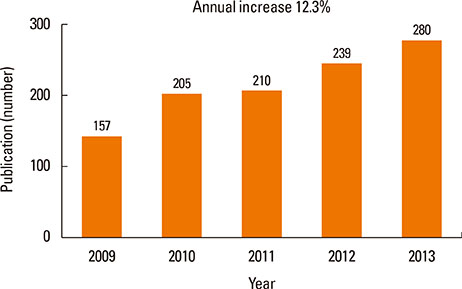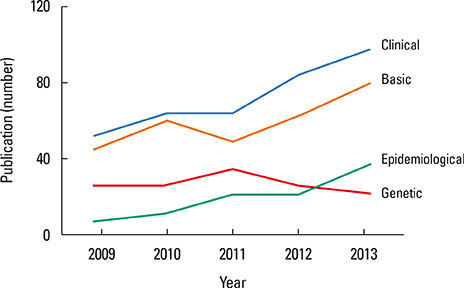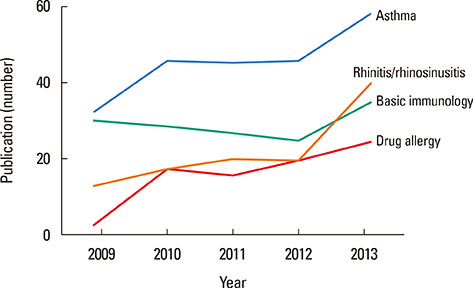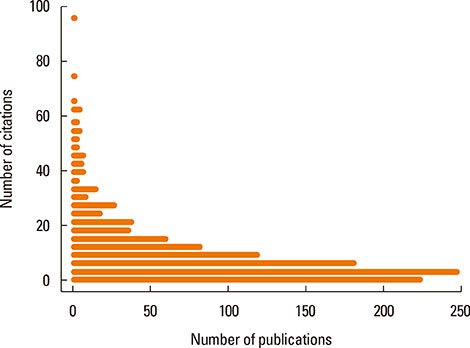Allergy Asthma Immunol Res.
2015 Sep;7(5):507-512. 10.4168/aair.2015.7.5.507.
Progress and Prospect: A Bibliometric Analysis of Research Papers by Korean Allergists Over Recent Five Years (2009-2013)
- Affiliations
-
- 1Department of Internal Medicine, Seoul National University College of Medicine, Seoul, Korea.
- 2Department of Pediatrics, CHA University School of Medicine, Seongnam, Korea.
- 3Department of Pediatrics, Seoul National University College of Medicine, Seoul, Korea.
- 4Department of Pediatrics, Soonchunhyang University College of Medicine, Seoul, Korea.
- 5Department of Pediatrics, College of Medicine, the Catholic University of Korea, Seoul, Korea.
- 6Department of Pediatrics, Childhood Asthma Atopy Center, Asan Medical Center, University of Ulsan College of Medicine, Seoul, Korea.
- 7Department of Internal Medicine, Hanyang University College of Medicine, Seoul, Korea.
- 8Department of Allergy and Clinical Immunology, Ajou University School of Medicine, Suwon, Korea.
- 9Department of Allergy and Clinical Immunology, Asan Medical Center, University of Ulsan College of Medicine, Seoul, Korea.
- 10Department of Otorhinolaryngology-Head and Neck Surgery, Kyung Hee Medical Center, Seoul, Korea.
- 11Department of Dermatology, Chung-Ang University College of Medicine, Seoul, Korea.
- 12Department of Internal Medicine, Inha University School of Medicine, Incheon, Korea. cwkim1805@inha.ac.kr
- KMID: 2147960
- DOI: http://doi.org/10.4168/aair.2015.7.5.507
Abstract
- Since the establishment of the academic society in 1972, Korean allergists have made continuous efforts to elucidate pathogenic mechanisms and therapeutic advances for allergic diseases. The present study aimed to summarize recent progress and explore future prospects of research performance by Korean allergists. We performed a comprehensive bibliometric analysis for research papers published in the Science Citation Index (SCI) or SCI-expanded journals by Korean allergists between 2009 and 2013. Research performance was quantitatively analyzed for the numbers of papers by publication year, research type, and main topic. In addition, the performance was also examined for qualitative indices, such as impact factor and citation number. A total of 1,091 papers were identified. The number of publication increased continuously, with an annual increase rate of 12.3%. Clinical and basic studies were the most frequent types of research, and recently the number of epidemiological studies has increased. By research topic, asthma was the most commonly studied, accounting for 20.9% of the total number of publications. Notably, the amount of rhinitis/rhinosinusitis research has risen steeply in 2013. Qualitative analyses also indicated continuous progress; the median impact factor of published journals increased from 1.918 in 2009 to 2.746 in 2013, yielding an annual increase rate of 7.4%. In conclusion, the present analyses identified a continuous increase in the research performance of Korean allergists over a recent 5 year period (2009-2013), both quantitatively and qualitatively. A more significant contribution is expected in the forthcoming era.
Keyword
Figure
Cited by 1 articles
-
Time trends of the prevalence of allergic diseases in Korea: A systematic literature review
Sung-Yoon Kang, Woo-Jung Song, Sang-Heon Cho, Yoon-Seok Chang
Asia Pac Allergy. 2018;8(1):. doi: 10.5415/apallergy.2018.8.e8.
Reference
-
1. Strachan DP. Hay fever, hygiene, and household size. BMJ. 1989; 299:1259–1260.2. Haahtela T, Holgate S, Pawankar R, Akdis CA, Benjaponpitak S, Caraballo L, et al. The biodiversity hypothesis and allergic disease: world allergy organization position statement. World Allergy Organ J. 2013; 6:3.3. Kim YM, Kim YS, Jeon SG, Kim YK. Immunopathogenesis of allergic asthma: more than the th2 hypothesis. Allergy Asthma Immunol Res. 2013; 5:189–196.4. Park SM, Park JS, Park HS, Park CS. Unraveling the genetic basis of aspirin hypersensitivity in asthma beyond arachidonate pathways. Allergy Asthma Immunol Res. 2013; 5:258–276.5. Holgate ST. Mechanisms of asthma and implications for its prevention and treatment: a personal journey. Allergy Asthma Immunol Res. 2013; 5:343–347.6. Kim BJ, Lee SY, Kim HB, Lee E, Hong SJ. Environmental changes, microbiota, and allergic diseases. Allergy Asthma Immunol Res. 2014; 6:389–400.7. Khoriaty E, Umetsu DT. Oral immunotherapy for food allergy: towards a new horizon. Allergy Asthma Immunol Res. 2013; 5:3–15.8. Ahn K. The usefulness of component-resolved diagnostics in food allergy. Allergy Asthma Immunol Res. 2014; 6:103–104.9. Olin JT, Wechsler ME. Asthma: pathogenesis and novel drugs for treatment. BMJ. 2014; 349:g5517.10. Hsu Blatman KS, Castells MC. Desensitizations for chemotherapy and monoclonal antibodies: indications and outcomes. Curr Allergy Asthma Rep. 2014; 14:453.11. Wong GW, Leung TF, Ko FW. Changing prevalence of allergic diseases in the Asia-pacific region. Allergy Asthma Immunol Res. 2013; 5:251–257.12. Yáñez A, Cho SH, Soriano JB, Rosenwasser LJ, Rodrigo GJ, Rabe KF, et al. Asthma in the elderly: what we know and what we have yet to know. World Allergy Organ J. 2014; 7:8.13. Song WJ, Kang MG, Chang YS, Cho SH. Epidemiology of adult asthma in Asia: toward a better understanding. Asia Pac Allergy. 2014; 4:75–85.14. Leung DY, Guttman-Yassky E. Deciphering the complexities of atopic dermatitis: shifting paradigms in treatment approaches. J Allergy Clin Immunol. 2014; 134:769–779.15. Wenzel SE. Asthma phenotypes: the evolution from clinical to molecular approaches. Nat Med. 2012; 18:716–725.16. Akdis CA, Bachert C, Cingi C, Dykewicz MS, Hellings PW, Naclerio RM, et al. Endotypes and phenotypes of chronic rhinosinusitis: a PRACTALL document of the European Academy of Allergy and Clinical Immunology and the American Academy of Allergy, Asthma & Immunology. J Allergy Clin Immunol. 2013; 131:1479–1490.17. Kim YY, Holgate ST, Church MK. Inhibition of histamine release from dispersed human lung and tonsillar mast cells by nicardipine and nifedipine. Br J Clin Pharmacol. 1985; 19:631–638.18. Kim YY. Past, present, and future of allergy in Korea. Allergy Asthma Immunol Res. 2010; 2:155–164.19. Röhrig B, du Prel JB, Wachtlin D, Blettner M. Types of study in medical research: part 3 of a series on evaluation of scientific publications. Dtsch Arztebl Int. 2009; 106:262–268.20. Park HS, Kim SR, Lee YC. Impact of oxidative stress on lung diseases. Respirology. 2009; 14:27–38.21. Ciprandi G, Caimmi D, Miraglia Del Giudice M, La Rosa M, Salpietro C, Marseglia GL. Recent developments in united airways disease. Allergy Asthma Immunol Res. 2012; 4:171–177.22. Bachert C, Pawankar R, Zhang L, Bunnag C, Fokkens WJ, Hamilos DL, et al. ICON: chronic rhinosinusitis. World Allergy Organ J. 2014; 7:25.23. Demoly P, Adkinson NF, Brockow K, Castells M, Chiriac AM, Greenberger PA, et al. International Consensus on drug allergy. Allergy. 2014; 69:420–437.24. Kim MH, Lee JM. Diagnosis and management of immediate hypersensitivity reactions to cephalosporins. Allergy Asthma Immunol Res. 2014; 6:485–495.25. Hong ST. Over the journal impact factor. J Korean Med Sci. 2013; 28:969.26. Park CS. AAIR, a leading open access journal in allergy, asthma and immunology research. Allergy Asthma Immunol Res. 2009; 1:1–2.27. Park CS. Congratulations are due to Allergy, Asthma, & Immunology Research (AAIR) on being listed in Web of Science (SCIE). Allergy Asthma Immunol Res. 2011; 3:145.28. Park CS. Congratulations to all are in order, as Allergy, Asthma & Immunology Research (AAIR) is going to change to a bimonthly publication from a quarterly one. Allergy Asthma Immunol Res. 2012; 4:1.29. Park HS. Embarking on a new journey with the Allergy, Asthma & Immunology Research. Allergy Asthma Immunol Res. 2014; 6:1–2.30. Harbour R, Miller J. A new system for grading recommendations in evidence based guidelines. BMJ. 2001; 323:334–336.31. Noruzi A. Google Scholar: the new generation of citation indexes. Libri. 2005; 55:170–180.32. Bakkalbasi N, Bauer K, Glover J, Wang L. Three options for citation tracking: Google Scholar, Scopus and Web of Science. Biomed Digit Libr. 2006; 3:7.
- Full Text Links
- Actions
-
Cited
- CITED
-
- Close
- Share
- Similar articles
-
- Bibliometric Analysis of the Korean Journal of Parasitology: Measured from SCI, PubMed, Scopus, and Synapse Databases
- Fifty Years of Cervical Myelopathy Research: Results from a Bibliometric Analysis
- Analysis of papers in the Journal of Korean Radiological Society of recent three years with special emphasis oncitation index
- The most influential articles on kidney transplantation: a bibliometric and visualized analysis
- Publication trends of somatic mutation and recombination tests research: a bibliometric analysis (1984‒2020)





